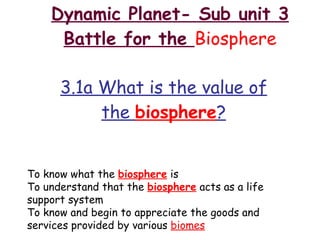
Lesson2valueofbiospheregoodsservices
- 1. Dynamic Planet- Sub unit 3 Battle for the Biosphere 3.1a What is the value of the biosphere ? To know what the biosphere is To understand that the biosphere acts as a life support system To know and begin to appreciate the goods and services provided by various biomes
- 10. They store carbon, a contributor to global warming They provide nutrients for soil to be productive They regulate the hydrological cycle They are a unique biome They provide homes for many endangered animals species- such as Orang-Utans, Bonobos, Poison Arrow frogs, etc Over 50% of the biological diversity on Earth is found in tropical rainforests Small monkeys called marmosets from rainforests are used to test drugs before human tests One rainforest drug is used to help diabetics Plants from rainforests are used in the contraceptive pill One rainforest drug, Rosie Periwinkle improved childhood leukaemia sufferers survival chance from 10 to 90% 25% of all cancer fighting drugs Rainforests are places we can visit on treks and holidays, increasingly as eco-tourists They provide saleable commodities like Rubber and timber Many indigenous people in rainforests live the way they have lived for centuries they can teach us a lot They are a source of Illegal drugs like cocaine They provide 80% of all western foods- like pineapple, coffee
- 13. How biosphere regulates carbon The carbon cycle http://www.youtube.com/watch?v=U3SZKJVKRxQ&feature=PlayList&p=C606EB957A1DDF22&playnext=1&playnext_from=PL&index=67 long video http://www.youtube.com/watch?v=0Vwa6qtEih8&feature=PlayList&p=C606EB957A1DDF22&playnext=1&playnext_from=PL&index=49 short video
- 14. Estimated major stores of carbon on the Earth. 4000 Fossil Fuel Deposits 540 to 610 Terrestrial Plants 66,000,000 to 100,000,000 Marine Sediments and Sedimentary Rocks 38,000 to 40,000 Ocean 1500 to 1600 Soil Organic Matter 578 (as of 1700) - 766 (as of 1999) Atmosphere Amount in Billions of Metric Tons Sink
- 17. question answer
- 18. question release CO2 volcanoes fossil fuels are burned carbon is released back into the atmosphere through carbon dioxide when breathing, or cellular respiration carbon is released back into the atmosphere by humans by by eating plants how do organisms get carbon by photosynthesis How is carbon taken in the environment show volcanoes fossil fuels are burned show show carbon is released back into the atmosphere by humans by show how do organisms get carbon by photosynthesis show answer
- 24. Nutrient Stores Nutrient Stores Soil. The amount of organic matter, including humus and leaf litter, in the soil. The total mass of living organisms, mainly plant tissue Soil Litter Biomass